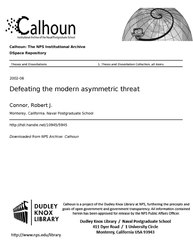File:Defeating the modern asymmetric threat (IA defeatingmoderns109455945).pdf

Original file (1,275 × 1,650 pixels, file size: 662 KB, MIME type: application/pdf, 172 pages)
| This is a file from the Wikimedia Commons. Information from its description page there is shown below. Commons is a freely licensed media file repository. You can help. |
Summary
| Defeating the modern asymmetric threat
( |
||
|---|---|---|
| Author |
Connor, Robert J. |
|
| Title |
Defeating the modern asymmetric threat |
|
| Publisher |
Monterey, California. Naval Postgraduate School |
|
| Description |
On February 24th, 2002 the Prime Minister of Sri Lanka entered into a Peace Agreement with the Liberation Tigers of Tamil Eelam (LTTE) ending a horrific 19 year-old low-intensity conflict. Over the course of nearly two decades, the LTTE came to exemplify the modern asymmetric threat as they battled the Sri Lankan Armed Forces (SLAF) and for a period an Indian Peace Keeping Force (IPKF). The anthropology in Chapter II, history in Chapter III, and explanation of the Tigers in Chapter IV describes most of the intricacies of the struggle. In particular, Chapter IV offers four explanations for the prolific use of suicide bombers by the LTTE: one strategic, one operational, one psychological and one religious. Chapter V conducts an analysis of the conflict to garner what lessons can be learned from the successes and failures of the SLAF and IPKF so that U.S. commanders can better prepare their troops for future battles against organizations employing similar tactics as the LTTE. Chapter V further tests my hypothesis that the four principles of Internal Defense and Development (IDAD) as currently defined in U.S. Joint Doctrine (maximum intelligence, minimum violence, unity of effort, and responsive government) are the applicable variables in defeating the modern asymmetric threat, even those that employ suicide bombers. I defined success in defeating the modern asymmetric threat as besting the threat sufficiently through military means that the enemy lays down his arms, gives up the use of his explosives, and seeks to end the conflict peacefully by political means. With the February signing of the peace accord, having been greatly assisted by the global effects of the 9/11 attacks in the U.S., the Sri Lankan government and its armed forces finally achieved success in defeating the LTTE according to this definit ion. Whether wittingly or unwittingly at the time, the Sri Lankans were adhering to all four principles of IDAD. Some may argue that without the effects of 9/11 this would not have been possible and this may very well be true, but it does not negate my argument. Chapter VI defends this conclusion and makes some further recommendations for improving the definitions of the IDAD principles so that young U.S. military officers and non-commissioned officers may be better prepared when they come face to face with similar threats in the near future. Subjects: Ethnic conflict; Sri Lanka; LTTE; Ethnic Conflict; Asymmetry; Suicide Terrorism; Foreign Internal Defense; Internal Defense and Development; Maximum Intelligence; Minimum Violence; Unity of Effort; Responsive Government; Special Operations; Low-Intensity Conflict |
|
| Language | English | |
| Publication date | June 2002 | |
| Current location |
IA Collections: navalpostgraduateschoollibrary; fedlink |
|
| Accession number |
defeatingmoderns109455945 |
|
| Source | ||
| Permission (Reusing this file) |
This publication is a work of the U.S. Government as defined in Title 17, United States Code, Section 101. Copyright protection is not available for this work in the United States. | |
Licensing
| Public domainPublic domainfalsefalse |
This work is in the public domain in the United States because it is a work prepared by an officer or employee of the United States Government as part of that person’s official duties under the terms of Title 17, Chapter 1, Section 105 of the US Code.
Note: This only applies to original works of the Federal Government and not to the work of any individual U.S. state, territory, commonwealth, county, municipality, or any other subdivision. This template also does not apply to postage stamp designs published by the United States Postal Service since 1978. (See § 313.6(C)(1) of Compendium of U.S. Copyright Office Practices). It also does not apply to certain US coins; see The US Mint Terms of Use.
|
 | |
| This file has been identified as being free of known restrictions under copyright law, including all related and neighboring rights. | ||
https://creativecommons.org/publicdomain/mark/1.0/PDMCreative Commons Public Domain Mark 1.0falsefalse
File history
Click on a date/time to view the file as it appeared at that time.
| Date/Time | Thumbnail | Dimensions | User | Comment | |
|---|---|---|---|---|---|
| current | 13:15, 16 July 2020 |  | 1,275 × 1,650, 172 pages (662 KB) | Fæ | FEDLINK - United States Federal Collection defeatingmoderns109455945 (User talk:Fæ/IA books#Fork8) (batch 1993-2020 #13042) |
File usage
Metadata
This file contains additional information, probably added from the digital camera or scanner used to create or digitize it.
If the file has been modified from its original state, some details may not fully reflect the modified file.
| Short title | Defeating the modern asymmetric threat |
|---|---|
| Author | Connor, Robert J. |
| Software used | Connor, Robert J. |
| Conversion program | Acrobat PDFWriter 5.0 for Windows NT |
| Encrypted | no |
| Page size | 612 x 792 pts (letter) |
| Version of PDF format | 1.4 |


